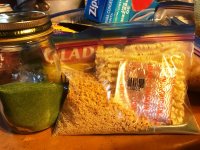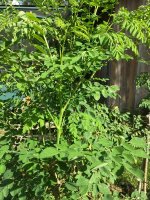- Joined
- Nov 30, 2017
- Messages
- 1,094
- Reaction score
- 1,497
No one else would probably want to do this, but just for the record, here is the dinner I am having most nights of a two week trip. This is a bland dinner. But I wanted something that is easy, easy, easy and does not use much fuel, and that doesn't cost so much.
Packed into a pint ziplock, it consists of one packet of chicken ramen noodles, a flavor packet from a second package of ramen noodles (minus the noodles), 1/2 cup of textured vegetable protein and 1 tablespoon of moringa powder. Boil 2 cups of water. Toss in the ramen noodles and TVP and simmer for three minutes, toss in flavor packets and moringa. Eat.
Total packing weight is 4 ounces per dinner. 24 grams of protein. 31 grams of carbs. And about 400 calories. You can increase the calories by adding olive oil or some other fat. Total cost for one meal is under $2. (You can buy way more moringa powder on amazon.com than you will ever need for $10. )
Mountain House Chicken Fried Rice (just as an example because it is on hand) packing weight for one serving is about four ounces (1/2 of the two serving pack). Protein is 14 grams. Carbs 45. Calories 360. Cost $5 per serving depending on where you buy it.
1 TBS of moringa powder added to the dish adds: 1.3 grams protein, 3 grams carbs, 73 mg potassium, vitamin A (15%), calcium (6%) and iron (8%), more or less depending on your source. I am using moringa powder instead of vegetables because all the dried and freeze-dried vegetables taste terrible to me. I also happen to grow moringa. It is a tropical plant, but it grows so fast, it can be grown summers in the north as an annual.
Photos show the pint ziplock with the entire dinner in it.; to the left is the moringa powder. Other photo shows growing moringa leaves.
Erica
Packed into a pint ziplock, it consists of one packet of chicken ramen noodles, a flavor packet from a second package of ramen noodles (minus the noodles), 1/2 cup of textured vegetable protein and 1 tablespoon of moringa powder. Boil 2 cups of water. Toss in the ramen noodles and TVP and simmer for three minutes, toss in flavor packets and moringa. Eat.
Total packing weight is 4 ounces per dinner. 24 grams of protein. 31 grams of carbs. And about 400 calories. You can increase the calories by adding olive oil or some other fat. Total cost for one meal is under $2. (You can buy way more moringa powder on amazon.com than you will ever need for $10. )
Mountain House Chicken Fried Rice (just as an example because it is on hand) packing weight for one serving is about four ounces (1/2 of the two serving pack). Protein is 14 grams. Carbs 45. Calories 360. Cost $5 per serving depending on where you buy it.
1 TBS of moringa powder added to the dish adds: 1.3 grams protein, 3 grams carbs, 73 mg potassium, vitamin A (15%), calcium (6%) and iron (8%), more or less depending on your source. I am using moringa powder instead of vegetables because all the dried and freeze-dried vegetables taste terrible to me. I also happen to grow moringa. It is a tropical plant, but it grows so fast, it can be grown summers in the north as an annual.
Photos show the pint ziplock with the entire dinner in it.; to the left is the moringa powder. Other photo shows growing moringa leaves.
Erica


